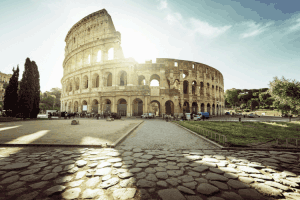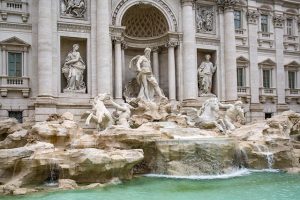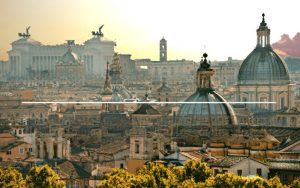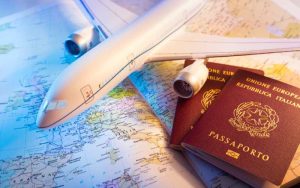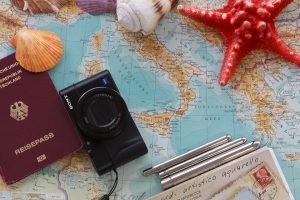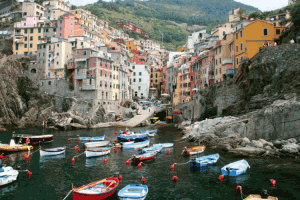If you are planning a trip to Italy, it is going to take time. Italy is a vast country full of cities with their own distinct beauty. Worry not! We are here with the top 15 cities in Italy that you might choose from to visit or maybe visit depending upon the length of your trip. These are the most popular cities in Italy among tourists.
Top 15 Cities In Italy
1. Rome
Rome, being the capital of Italy, has most of everything Italy has to offer, especially a glimpse into the History of the Roman Empire with the ruins of ancient buildings and wonderful architecture present. It is the most famous city in Italy.
Best Months to Visit Rome : April, May, September, and October are the best months to visit Rome. The weather is pleasant. The crowds are smaller which is ideal for those who do not like too much company. Also hotel rates are lower. Everyone loves lower prices!
How Long to Visit Rome For : Spending at least 3-4 days in Rome is good to see the major sights. Let the city’s charm sink in. However, Italy is a big country and you might run short of time. In that case you can see many of the highlights in 2-3 days.
Must-See Places in Rome : The Colosseum , Trevi Fountain , The Vatican city, Roman Forum ,Palatine Hill , Pantheon
What to Eat in Rome: Pizza, Gelato, Saltimbocca
How to Save Money in Rome:
- Purchase a Roman Pass. It will give you free entry to two ticketed attractions. Also you can access free public transportation in Italy for the duration of the pass.
- Stop by museums on the first Sunday of the month. Many museums in Rome do not charge on this day.
- Tap water is safe to drink in Rome. Save money by not buying any bottled water.
- Rome is a very walkable city. Hence, you can save money on transportation by exploring on foot.
- Seek out local restaurants. You will have a far more authentic and affordable dining experience.
Things to Do in Rome
- Spare a coin to toss into the Trevi Fountain if you want to come back. The Baroque fountain is said to ensure your return to Rome.
- Wander the charming streets of the Trastevere neighborhood. We recommend an Italian street art tour to check out the creative side of the country.
- Climb the Spanish Steps. View the scenery from the top of Piazza di Spagna.
- Learn inside out about Roman history at the Capitoline Museums.
- Sample the delicious food of Rome. From pizza and pasta to gelato, taste it all!
- Take a cooking class. Master making traditional Roman dishes.
- See a performance at the Rome Opera House.
- Relax in a park. Such as the Villa Doria Pamphili or the Gianicolo.
Read More: Things To Do In Rome
2. Venice
Venice is a city no less than a dream. It has no roads. Instead, navigation is done by gondolas, water taxis and private boats. Sounds unreal, does it not? It is built on over 100 small islands in a lagoon in the Adriatic Sea, northern region with some of the most iconic Italian spots. Venice is no doubt one of the best cities to visit in Italy.
Best Months to Visit Venice: Shoulder seasons, again, are the best times to visit Venice. Venice gets thronged during the summer months.
How Long to Visit Venice For: Venice is a beautiful but small city. You can easily view the main sights in 2-3 days.
Must-See Places in Venice: Mark’s Square, The Rialto Bridge, Gondola Ride, Basilica di San Zanipolo, Gallerie dell’Accademia
What to Eat in Venice: Cicchetti, Spaghetti alle vongole ,Frittura mista
How to Save Money in Venice
- Consider staying on the mainland. Here hotels are generally cheaper. Mestre is a good option. It’s just a short train ride from Venice.
- Buy a Venezia Unica Pass. This pass gives you free admission to many of Venice’s top attractions and unlimited travel on the Vaporetto water bus.
- There are many beautiful spots in Venice to enjoy a picnic lunch. Pack one and save money on some meals.
- Many restaurants and shops in Venice demand unreasonable prices from visitors. Do some research before you go and avoid such places.
- Venice is a very walkable city. A walk enables you to slowly breathe in the city’s beauty and save your pockets a little.
Things to Do in Venice
- Traverse the Grand Canal. Take a gondola ride or a vaporetto.
- Saunter the streets of Venice. Weaved together like a maze, they are best explored on foot.
- Enjoy the Cicchetti scene. It is a small Venetian snack. Similar to tapas.
- Go to the opera. Venice is home to the famous La Fenice opera house.
- Stop by the Peggy Guggenheim Collection. It is a modern and contemporary art museum.
- Explore the Jewish Ghetto. It is the oldest ghetto in the world. Know inside out about the history of the Jewish people in Venice.
Read More: Best Day Trips From Venice
3. Florence
Full of Renaissance architectures and art centers, Florence is rightly named “Cradle of Renaissance”. The city is filled with palaces, churches, and civic buildings that tell the story of its past.
Best Months to Visit Florence: Shoulder seasons such as April-May and September-October are the best times to visit Florence as well. You can also visit in the summer. Only if you don’t mind the crowds and hot weather.
How Long to Visit Florence For: Spending at least 3-4 days in Florence is good to see the major sights. Let the city’s charm sink in. However, Italy is a big country. You might run short of time. In that case, you can see many of the highlights in 2-3 days.
Must-See Places in Florence: Florence Cathedral (Duomo), Accademia Gallery, Uffizi Gallery, Ponte Vecchio, Palazzo Vecchio, Boboli Gardens, Piazzale Michelangelo
What to Eat in Florence: Florentine steak, Pasta al ragù, Ribollita, Lampredotto
How to Save Money in Florence
- Purchase a Firenze Card. It gives you free entry to many of Florence’s top museums and attractions. Plus, you enjoy free public transportation for the duration of the pass.
- Stop by museums on the first Sunday of the month. Take advantage of free walking tours to see the city. Learn about its history and culture.
- Eat at local trattorias. Trattorias are casual restaurants that serve traditional Tuscan food and are cheaper.
- Avoid tourist menus. Tourist menus are often overpriced and not very good.
- Taxis in Florence are expensive. Use the public transportation system or walk instead.
- Tap water is safe to drink in Florence. Save money by not buying any bottled water.
Things to Do in Florence
- Learn to Make Pizza or Pasta. Take a cooking class. Master making traditional Tuscan dishes.
- Sample Local Wines. Set the seal on trying a glass of Chianti or Brunello di Montalcino.
- Do some Shopping.
- Relax in a Piazza. Florence has many beautiful piazzas. Some of the delicious ones that the locals vouch for are Piazza Santa Croce and Piazza della Signoria.
- Catch a Performance. Florence has a vibrant opera and classical music scene. There are also often outdoor performances in the summer.
Read More: Things To Do In Florence
4. Milan
Milan is known as the Fashion Capital, and rightfully so, with its shops and galleries full of trendy fashion pieces at the most pocket-friendly prices. But it does not mean that it fall short of architectural beauty than any other cities.
Best Months to Visit Milan: Milan is a great city to visit year-round. But the best weather is in the spring- April to June, and fall- September to October. The temperatures are mild and comfortable. Ideal for sightseeing.
How Long to Visit Milan For: Spending at least is good 3-4 days in Milan to see the major sights. Let the city’s charm sink in. However, Italy is a big country. You might run short of time. In that case, you can see many of the highlights in 2-3 days.
Must-See Places in Milan: The Duomo, The Scala Opera House, The Galleria Vittorio Emanuele II, Sforza Castle, The Navigli, Brera District, Santa Maria delle Grazie, Pinacoteca di Brera
What to Eat in Milan: Risotto alla Milanese, Cotoletta alla Milanese, Ossobuco, Panettone
How to Save Money in Milan
- Purchase a Milan Pass. It gives you free entry to many of Milan’s top attractions. Also free public transportation for the duration of the pass.
- Stop by museums on the first Sunday of the month. Many museums in Florence do not charge on this day.
- Take advantage of free walking tours to see the city. Learn about its history and culture.
- Eat at local trattorias. Trattorias are cheaper casual restaurants that serve traditional food. Avoid tourist traps where prices tend to be higher.
- Take shelter in a hostel or apartment. They can be a more affordable option than hotels.
Things to Do in Milan
- Sip canalside drinks in the Navigli District. It is a neighborhood with a lively nightlife scene.
- See ‘The Last Supper’ by Leonardo da Vinci. This masterpiece can be found in the church of Santa Maria delle Grazie.
- Catch a performance at the Teatro alla Scala.
- Check out the uncanny treasures at the Ambrosian Library. One of being a skull believed to be that of Leonardo da Vinci.
- Do some shopping in the Quadrilatero della Moda. It is Milan’s famous fashion district.
- Enjoy a traditional Milanese meal. Such as risotto alla Milanese or cotoletta alla Milanese.
Read More: Things To Do In Milan
5. Capri
Capri includes the famous Blue Grotto, a dark cavern where the water glows an electric blue due to sunlight. It is a stunning city famous for its beaches and cliffs. Beach babies, assemble!
Best Months to Visit in Capri: Capri has a Mediterranean climate. The summer season has a warm and dry touch to it, while winters offer mild temperature. The island truly comes alive in the spring and shoulder seasons- April-May and September-October. You’ll experience pleasant weather, fewer crowds, and blooming flowers. Avoid July and August, the peak tourist months, if you prefer a quieter experience.
How Long to Visit Capri For: Capri is a small island. The main sights can be viewed in 2-3 days.
Must-See Places in Capri: Blue Grotto, Faraglioni Rocks, Giardini di Augusto, Piazza Umberto I, Villa San Michele
What to Eat: Caprese Salad, Spaghetti alla Nerano, Ravioli Capresi, Sea Bass
How to Save Money in Capri
- Flights and accommodation are low-cost during the shoulder seasons.
- Ferries are a more thrifty way to get to Capri than private boats.
- There are plenty of aesthetic sites in Capri to enjoy a picnic lunch. Pack one and save money on some meals.
- Capri is a small island. Most of the sights can be reached on foot.
- Many B&Bs in Capri offer a more affordable alternative to luxury hotels.
Things to Do in Capri
- Take a boat tour. This is a great way to see the island’s grottoes. Especially the famous Blue Grotto. It is only accessible by boat.
- Hike up Mount Solaro. This is the highest point on the island. You can imagine the view it would promise!
- Loosen yourself and relax on the beach. Capri has several beautiful beaches to sunbathe and enjoy the views.
- Go shopping. Capri is a famous shopping destination.
- Take a cooking class. Master making traditional Capri dishes.
- Go for a swim. The waters around Capri being crystal-clear, are perfect for swimming.
- Go snorkeling or diving.
Read More: Capri Day Trip
6.Naples
Naples is mostly known for tremendous things to do in Pompeii, whose ruins are in close proximity to this city. So is Mount Vesuvius, the active volcano that is known to have buried Pompeii. Naples is known for its strong coffee, delicious pizza (said to be the original), and chaotic charm.
Best Months to Visit Naples: Naples has a Mediterranean climate. Summers are warm and dry. Winters are mild. The island truly comes alive in the spring and shoulder seasons- April-May and September-October. You’ll experience pleasant weather, fewer crowds, and blooming flowers.
How Long to Visit Naples For: The duration you wish to stay for totally depends on you. Three to four days is a good starting point for seeing the major sights and experiencing the city’s culture. To explore the Amalfi Coast or other nearby destinations, you’ll need to invest extra time.
Must-See Places in Naples
- Pompeii and Herculaneum
- Mount Vesuvius
- Castel Nuovo
- Royal Palace of Naples
- San Carlo Theatre
- Capodimonte National Museum
What to Eat in Naples: Pizza, Pizza frittata, Spaghetti alle vongole, Sfogliatella, Baba
How to Save Money in Naples
- Flights and accommodation are low-cost during the shoulder seasons.
- Purchase a Naples Pass. It gives you free entry to many of Naples’ top attractions. Plus free public transportation for the duration of the pass.
- Take advantage of free walking tours to see the city. Learn about its history and culture.
- Eat at local restaurants. Avoid tourist traps where prices tend to be higher.
- Take shelter in a hostel or apartment. They can be a more affordable option than hotels in Italy.
- Explore the historic center.
- Stop by the archaeological museums.
- Go trekking. Mount Vesuvius is a good option being the only active volcano in Europe mainland.
- Loosen yourself and relax on the beach. Naples has many beaches due to its beautiful coastline.
- Naples is the birthplace of pizza. Try a slice or two for sure.
7. Bologna
Bologna is nicknamed the “red city” due to its terracotta rooftops. It is famous for its university, which is said to be the oldest in the western world. The culinary situation here is mouth-watering.
Best Months to Visit
- Spring (April – June): Pleasant weather. Fewer crowds and beautiful flowers in bloom.
- Summer (July – August): Hot and humid weather. Many locals take vacations in August. Visit if you don’t mind the crowds.
- Autumn (September – October): Pleasant weather with mild temperatures. Fewer crowds. Enjoy outdoor activities and explore the city.
- Winter (November – March): The coldest and wettest time of year. Fewer crowds. Lower prices. This makes it ideal for those following a budget travel guide to Italy.
How Long to Visit Bologna For: Bologna is a relatively small city. You can see the main sights in 2-3 days. You could easily spend a week here if you want to relax and soak up the atmosphere.
Must-See Places in Bologna: Piazza Maggiore, Le Due Torri, Sanctuary of Santa Maria della Vita ,National Pinacoteca
What to Eat in Bologna: Tagliatelle al ragù, Tortellini, Mortadella, Prosciutto, Parmigiano Reggiano
How to Save Money in Bologna
- Visit during the shoulder seasons. Prices for flights and hotels are typically lower during the spring and autumn.
- Get a Bologna Welcome Card. Gives you free access to many of the city’s museums. Public transportation is included as well.
- Take advantage of free walking tours to see the city. Learn about its history and culture.
- Eat at local restaurants. Avoid tourist traps where prices tend to be higher.
- Take shelter in an apartment. It can be a more affordable option than hotels.
- Know inside out about the history of the University of Bologna. It is the oldest in the Western world.
- Explore Piazza Maggiore. It is the heart of Bologna.
- Climb the Asinelli and Garisenda Towers.
- Wander through the Quadrilatero. It is Bologna’s historic market district.
- Take a cooking class. Master making traditional Bolognese dishes.
- Watch a performance at the Teatro Comunale di Bologna.
8.Verona
Verona is the city of romance, and is the place where Shakespeare’s famous Romeo and Juliet are said to have met. Juliet’s Balcony from where her heart used to call Romeo’s name is a famous tourist place in Verona.
Best Months to Visit Verona: The best months to visit Verona are April, May, September, and October. The weather is mild during these times, perfect for exploring the city on foot. Verona can get quite crowded and hot in summers.
How Long to Visit Verona For: Verona is a relatively small city. You can see the main sights in 2-3 days.
Must-See Places in Verona: Arena di Verona, Juliet’s House, Piazza delle Erbe, Castelvecchio, Ponte Scaligero
What to Eat in Verona: Bigoli, Risotto all’Amarone, Pastisada, Tortellini di Valeggio, Pandoro
How to Save Money in Verona
- Purchase a Verona Card. It gives you free entry to many of Verona’s top attractions. Also free public transportation for the duration of the pass.
- Take advantage of free walking tours to see the city. Learn about its history and culture.
- Eat at local restaurants. Avoid tourist traps where prices tend to be higher.
- Take shelter in a hostel or apartment. They can be a more thrifty option than hotels.
- Avoid visiting Verona during peak season (July and August) when costs are highest.
- Watch the famous balcony scene reenactment of “Romeo and Juliet” at Casa di Giulietta.
- Chill out in the Giardino Giusti. It is a beautiful Renaissance garden.
- Take a day trip to Lake Garda. It is a beautiful lake that is located near Verona.
- Take a cooking class. Master making traditional Veronese dishes.
- Encounter wine tasting on a tour to the Valpolicella wine region.
- See an opera performance at the Verona Arena.
- Attend a concert or other event at the Teatro Romano.
Read More: Best Time To Visit Italy Month By Month Guide
9.Orvieto
Visualize a medieval town perched dramatically on volcanic rock, offering stunning scenery. Yes, that’s Orvieto! It is a beautiful hilltop town in Umbria. Even its name is enchanting.
Best Months to Visit Orvieto: Milan is a great city to visit year-round. But the best weather is in the spring- April to June, and fall- September to October. The temperatures are mild and comfortable. Ideal for sightseeing.
How Long to Visit Orvieto For: Spending at least is good 3-4 days in Milan to see the major sights. Let the city’s charm sink in. However, Italy is a big country. You might run short of time. In that case, you can see many of the highlights in 2-3 days.
Must-See Places in Orvieto: Orvieto Cathedral, Pozzo di San Patrizio, Orvieto Underground, Necropolis of Monterozzi, La Rocca
What to Eat in Orvieto: Truffles, Wild boar, Pecorino cheese, Lentil soup
How to Save Money in Orvieto
- Flights and accommodation are low-cost during the shoulder seasons. Look for deals online.
- Purchase an Orvieto Card. You get free admission to many of the city’s top attractions. Also, discounts on restaurants and shops.
- Take advantage of free walking tours to see the city. Learn about its history and culture.
- There are plenty of aesthetic parks or gardens in Capri to enjoy a picnic lunch. Pack one and save money on some meals.
- Take shelter in a vacation rental or apartment instead of a hotel.
Things to Do in Orvieto
- Explore what’s beneath Orvieto. Orvieto has a fascinating network of caves and tunnels. These were used by the Etruscans for centuries.
- Encounter wine tasting. There are many wineries here that offer tastings.
- Enjoy the view from Torre del Moro.
- Shop for souvenirs. Such as local crafts, food, and wine.
10. Positano
It is a romantic city with colorful houses cascading down cliffs that meet the sparkling Mediterranean Sea. This city is a dessert for the eyes after the feast your eyes have while being in Italy.
Best Months to Visit Positano: The best time to visit Positano is during late spring (May to June) and early fall (September to October). The weather is pleasant with warm temperatures. There are fewer crowds than in the peak summer season.
How Long to Visit Positano For: The highlights of Positano can be seen in maximum 2-3 days.
Must-See Places in Positano: Positano Beach, Church of Santa Maria Assunta, Path of the Gods
What to Eat in Positano: Spaghetti alle vongole, Ravioli caprese, Limoncello
How to Save Money in Positano
- Take shelter in a vacation rental. They often have kitchens. So you can cook some of your own meals.
- Take advantage of free activities. Such as hiking, swimming, and exploring the town.
- Pack light. You can avoid having to pay checked baggage fees.
Things to Do in Positano
- Loosen yourself and relax on the beach. Positano has several beaches. All with stunning views.
- Take a boat tour. It is a great way to see the Amalfi Coast differently.
- Go hiking.
- Shop for souvenirs and local crafts. Such as limoncello and hand-painted clothes.
- Devour the food. Don’t forget to try the gelato for dessert!
11. Turin
Turin, in northern Italy, is a city that blends history, industry, and elegance. It is famously nicknamed “The Detroit of Italy” for its car manufacturing, which includes FIAT.
Best Months to Visit Turin:
- Visit during Spring (April-May) and autumn (September-October). The weather is mild and comfortable.
- Summer (June-August) can be hot and humid. There are many Italy’s festivals and event celebrations to make merry.
- Winters (December-February) are cold and snowy. The city is decorated for the holidays. Plus there are fewer crowds.
How Long to Visit Turin For: Turin can be enjoyed over a weekend. But there is enough to view and do to keep you engaged for a week or more.
Must-See Places in Turin
- Egyptian Museum
- Royal Palace of Turin
- Mole Antonelliana
- Basilica di Superga
- Sacra di San Michele
What to Eat in Turin: Agnolotti, Bagna cauda, Gianduja
How to Save Money in Turin
- Buy the Torino + Piemonte Card. It offers free admission to over 200 museums and attractions in Turin and the Piedmont region. Plus free public transportation.
- Take advantage of free walking tours to see the city. Learn about its history and culture.
- Stop by museums on the first Sunday of the month. Many museums in Turin do not charge on this day.
- Seek out local restaurants.
- Take shelter outside of the city center, which is cheaper.
Things to Do in Turin
- Spare a day for museum-hopping. Turin has a wide variety of museums to suit all interests.
- Explore Turin’s historic center.
- Relax in a park.
- Sample the local cuisine.
- Catch a performance at the Teatro Regio.
- Take a day trip to the Alps.
12. Siena
Siena is like time-traveling back to medieval Italy. The city is divided into 17 historic districts, each with its own identity and traditions. Siena consists of the Monte dei Paschi. It is the world’s oldest continuously operating bank, founded in 1472.
Best Months to Visit Siena: The best time to visit Siena is during the shoulder seasons: spring (April-May) and fall (September-October).
How Long to Visit Siena For: Siena is a small city that can be easily explored in 2-3 days.
Must-See Places in Siena: Piazza del Campo, Cathedral, Santa Maria della Scala, Palazzo Pubblico and Torre del Mangia, National Picture Gallery, Basilica of San Domenico
What to Eat in Siena: Pici, Ribollita, Cinta Senese, Pecorino Toscano, Panforte
How to Save Money in Siena
- Siena is a walkable city. Save money on transportation by exploring on foot.
- Purchase a Siena Pass. It gives you free entry to many of the city’s top attractions. Plus discounts on others.
- Eat at local restaurants rather than tourist traps.
- Take shelter in an apartment rather than a hotel.
Things to Do in Siena
Let us look at some interesting things to do in Siena:
- Take a walking tour. Learn about the history and culture.
- Visit the Palio Museum. It is obligated to the Palio horse race.
- Encounter wine tasting in the Chianti Classico region, which Siena is the heart of. Set the seal on taking a day trip to explore the vineyards and wineries.
- Take a cooking class. Master making traditional Tuscan dishes.
- Go hiking or biking in the country. The area around Siena is beautiful. There are many trails to explore.
- Attend a concert or opera. Siena has a lively cultural scene.
13. Perugia
Founded by Etruscans, it consists of beautiful Etruscan walls and tombs. With its 13th-century walls still intact, Perugia is a maze of beautiful streets weaved like a cobble together. It is one of the best Etruscan sites in Italy. It is also a university town buzzing with a youthful energy.
Best Months to Visit Perugia: Capri has a Mediterranean climate. Summers are warm and dry, while it is the favourable place to visit in winter in Italy due to milder temperatures. The place truly comes alive in the spring and shoulder seasons- April-May and September-October. You’ll experience pleasant weather and fewer crowds.
How Long to Visit Perugia For: Perugia is a small city. You can easily see the highlights in 2-3 days.
Must-See Places in Perugia: Piazza IV Novembre, Cathedral of San Lorenzo, National Gallery of Umbria, Rocca Paolina, Etruscan Well, San Marco, Oratorio di San Bernardino, Hypogeum of the Volumnia Family
What to Eat in Perugia: Strangozzi, Sagrantino di Montefalco, Lentil Soup, Torta al Testo, Black Truffles
How to Save Money in Perugia
- Purchase a Perugia Card. It gives you free entry to many of the city’s museums and attractions. Plus discounts on public transportation.
- Take advantage of free walking tours.
- There are plenty of aesthetic sites in Perugia to enjoy a picnic lunch. Pack one and save money on some meals.
- Skip the taxis and take the public bus or walk.
Things to Do in Perugia
- Explore the historic center.
- Visit the Perugina Chocolate Museum. Learn about the history of chocolate making in Perugia.
- Loosen yourself and relax at Lake Trasimeno, the largest lake in central Italy.
- Go on a truffle hunt. There are a number of truffle hunting tours available in Perugia.
- Know inside out about the Etruscan past.
14. Cinque Terre
Cinque Terre means “Five Lands” in Italian. It is a string of five centuries-old fishing villages that stand on top of the cliffs that run along the rugged Italian Riviera coastline. These villages are known for their beauty and charm. As cars are not allowed within the villages themselves, these villages are connected by hiking trails, trains, and boats.
Best Months to Visit Cinque Terre:
- Shoulder Seasons (April-May & September-October) offer pleasant weather. Fewer crowds and lower prices are there. This is a great time to go hiking in Italy and enjoy the beautiful scenery. Without feeling overwhelmed by tourists!
- Summer (June-August) is the peak season in Cinque Terre. Weather is the hottest. The city is thronged. Although it is a great time to enjoy the beaches.
- Winter (November-March) has mild weather. But transportation schedules are reduced. A lot of shops and restaurants are closed. This is the cheapest time to visit.
How Long to Visit Cinque Terre For: 2-3 days are enough if you want to just relax on the beach. If you want to hike the trails between the villages, explore the towns, and go swimming and boating, you could spend a week here.
Must-See Places in Cinque Terre: Monterosso al Mare, Vernazza, Corniglia, Manarola, Riomaggiore
What to Eat in Cinque Terre: Pesto, Acciuga, Farinata, Sciacchetra
How to Save Money in Cinque Terre
- Consider taking shelter in a nearby town and commuting to Cinque Terre by train or ferry.
- There are plenty of aesthetic sites in Perugia to enjoy a picnic lunch. Pack one and save money on some meals.
- Buying groceries at the local markets is a great way to save money on food.
Things to Do in Cinque Terre
- Hike the trails. Cinque Terre has trails that connect all its five villages.
- Loosen yourself and relax on the beach.
- Go for a boat tour. A boat tour is a great way to see the Cinque Terre differently.
- Sample the local wines. Such as Vermentino and Sciacchetrà.
- Take a cooking class. Master making traditional Ligurian dishes, such as pesto and focaccia.
- Go stand-up paddleboarding.
15. Parma
Parma is in Emilia-Romagna. It might not be common for tourists to choose among cities to visit in Italy, but it is one of the best cities in Italy. Founded by the Romans, it is filled with Romanesque architecture like the frescoed Cathedral and the Baptistery. The Parmigiano Reggiano cheese and Parma ham of Parma are famous worldwide for watering the mouths of almost all.
Best Months to Visit Parma: The best time to visit Parma is during the spring (April-May) or fall (September-October) months. The weather is mild and comfortable. Lets you avoid the crowds and high prices.
How Long to Visit Parma For: 2-3 days is a good amount of time to spend in Parma. This will allow you to see the main sights. Plus, enjoy the food scene.
Must-See Places in Parma: Parma Cathedral, Palazzo della Pilotta, Teatro Regio, Church of San Giovanni Evangelista, Parco Ducale
What to Eat in Parma: Prosciutto di Parma, Parmigiano-Reggiano cheese, Tortelli, Culatta di Zibello
How to Save Money in Parma
- Buy a Parma Card. It grants free entry to many of the city’s museums and attractions. Plus, discounts on transportation and other services.
- Take advantage of free walking tours to see the city.
- Eat at local trattorias. Trattorias are casual restaurants that serve traditional food and are cheaper.
- Stay outside the city center. Parma has a good public transportation system. So getting around won’t be a problem.
Things to Do in Parma
- Take a food tour to sample the city’s signature dishes.
- Master making these specialties yourself in a cooking class.
- Drop by the Parmigiano Reggiano Cheese Museum. Learn about the history and production of the cheese.
- Stop by Fidenza Village. It has great deals on designer clothes.
What to Pack for Italy
- Weather in Italy differs depending on the season. Pack according to the weather. You can carry layers to mix and match to create different outfits.
- Choose comfortable shoes. They will assist you to walk on cobblestone streets.
- Pack light. Airlines have weight restrictions for baggage. Opt for clothing weaved of lightweight and breathable fabrics.
- Consider a travel adapter. Italy uses a different plug type than some countries. A travel adapter will allow you to charge your electronic devices.
- Pack a swimsuit to lay by the beach or pool and get a beautiful tan.
- Pack travel-sized toiletries. Save space in your bag.
- Have a first-aid kit with essential medications.
- Carry a camera and take pictures to remember Italy by.
- Carry a Money belt or crossbody bag for your money and valuables. Do not let pickpocketers win.
- You may need to pack additional items according to your intent. For example- you’ll entail hiking boots if you want to go hiking.
Why Do You Need To Visit Italy
Italy is a dream terminus for many travelers. For good reason, of course! Here are some of the top reasons why you should consider adding Italy to your bucket list:
A Living Museum: Italy is steeped in history. It boasts numberless ancient ruins and architectural wonders. Also, art masterpieces. There’s a piece of history waiting to be explored wherever you go.
Foodie Paradise: Italian cuisine is eminent for its fresh and flavorful ingredients. They piece together delicious dishes.
Cultural Delights: Italy’s rich culture is perceptible in its traditions and festivals. Submerge in the passionate spirit and laid-back lifestyle. Jump into the way of life and the art of conversation Italians are known for.
Breathtaking Landscapes: Italy offers stunning natural beauty beyond the bustling cities. Ease up on the beaches of Sardinia. Cruise along the Amalfi Coast. Do all that you have ever wanted to do!
Romantic Getaway: Picture yourself with your lover in Italy’s charming villages and the picturesque canals of Venice. The stunning sunsets creating a magical atmosphere make it a perfect destination for a romantic getaway.
Fashion Capital: Milan is a global fashion hub and Italy is known for its style and design. Explore high-end boutiques. Discover local treasures while shopping in Italy.
Ultimately, visiting Italy is a chance to create memories that will last a lifetime!
Traveling Tips
- Take Advantage of the Train System. It is an opportune way to travel between cities. Purchase your tickets online or at the train station.
- Research the best time of year to visit. Italy has a long coastline and a mountainous interior. The weather can differ depending on where you go.
- Book everything you can way in advance. Especially if you are going during peak season.
- Learn a few basic Italian phrases to help you communicate with locals. Even a simple “grazie” or “prego” is fine.
- Pack light. You will be doing a lot of walking in Italy. Do not be weighed down by a heavy suitcase.
- Purchase a museum pass if you plan on visiting a lot of museums. This can save you money on entrance fees.
- Be aware of pickpockets. Pickpocketing is a common problem in tourist destinations around the world. Including Italy.
- Haggling is not expected. Prices are fixed in most cases. Although there may be some exceptions such as at flea markets or open-air markets.
- Tipping is not mandatory. However, it is customary to leave a small tip. Only if you are happy with the service you received at a restaurant.
- Be prepared for slow service. Meals in Italy are meant to be savored. Do not expect to be rushed in and out of a restaurant.
- Embrace the siesta. Many businesses in Italy close for a siesta in the afternoon. Normally from 1 pm to 4 pm.
- Learn about Italian coffee culture. Coffee is a way of life in Italy. Different types of coffee drinks are served at different times of day. For example- cappuccino is typically enjoyed for breakfast. While espresso is a more common after-dinner drink.
